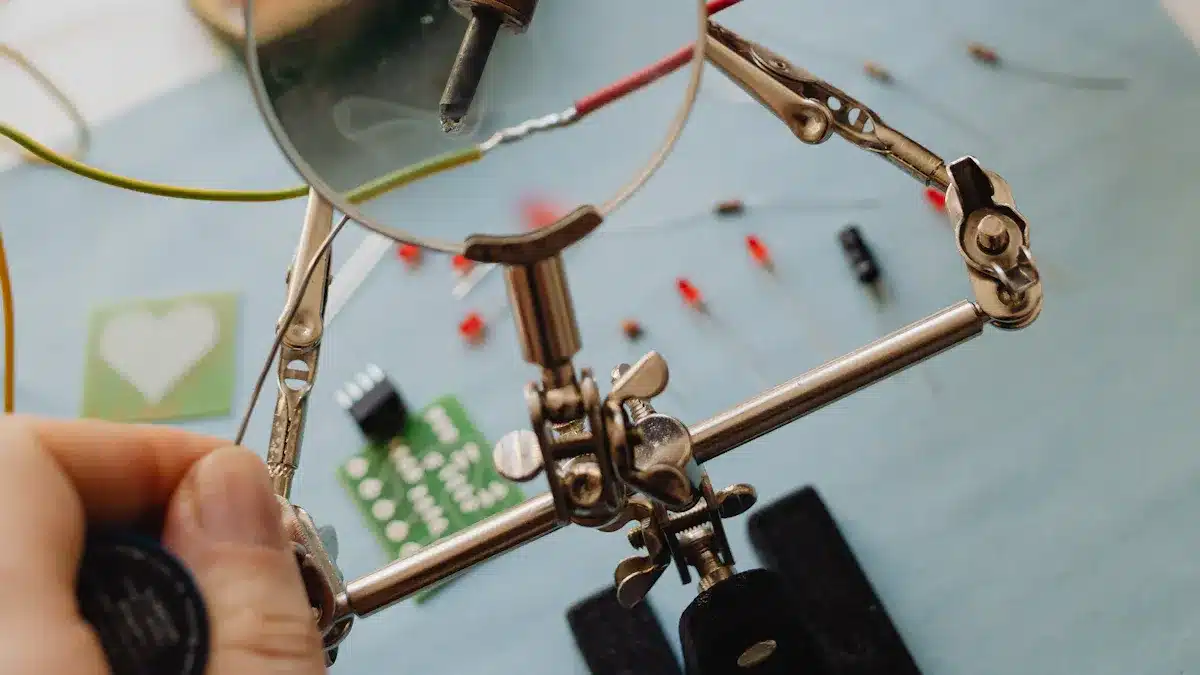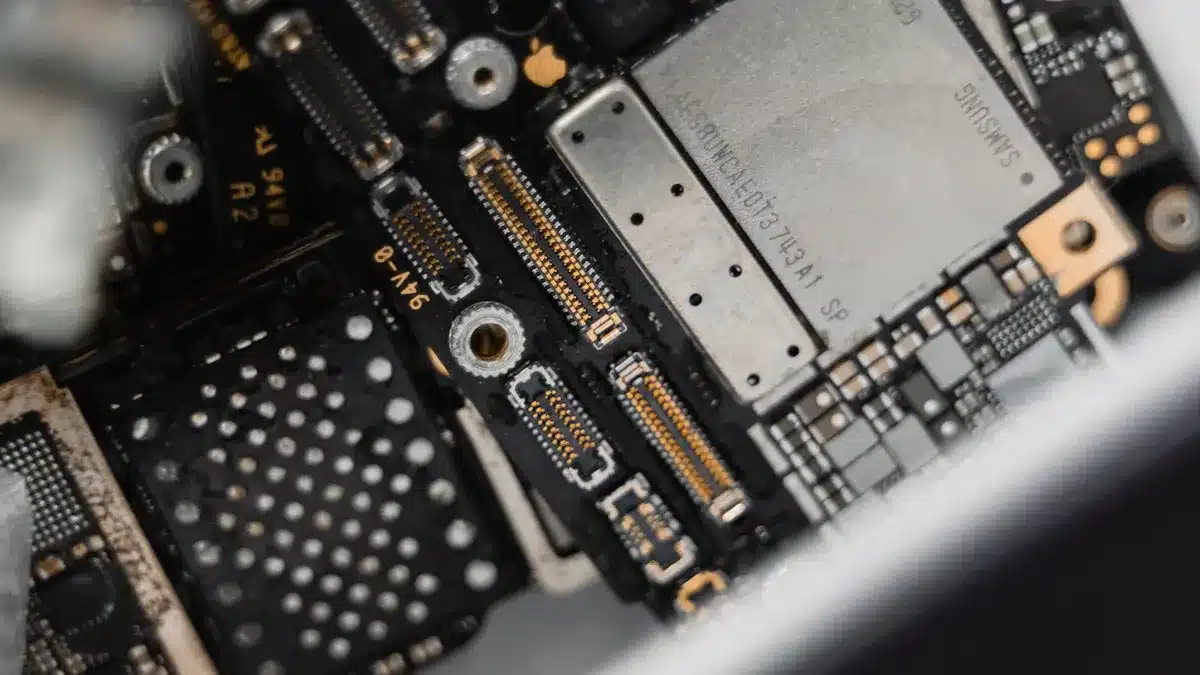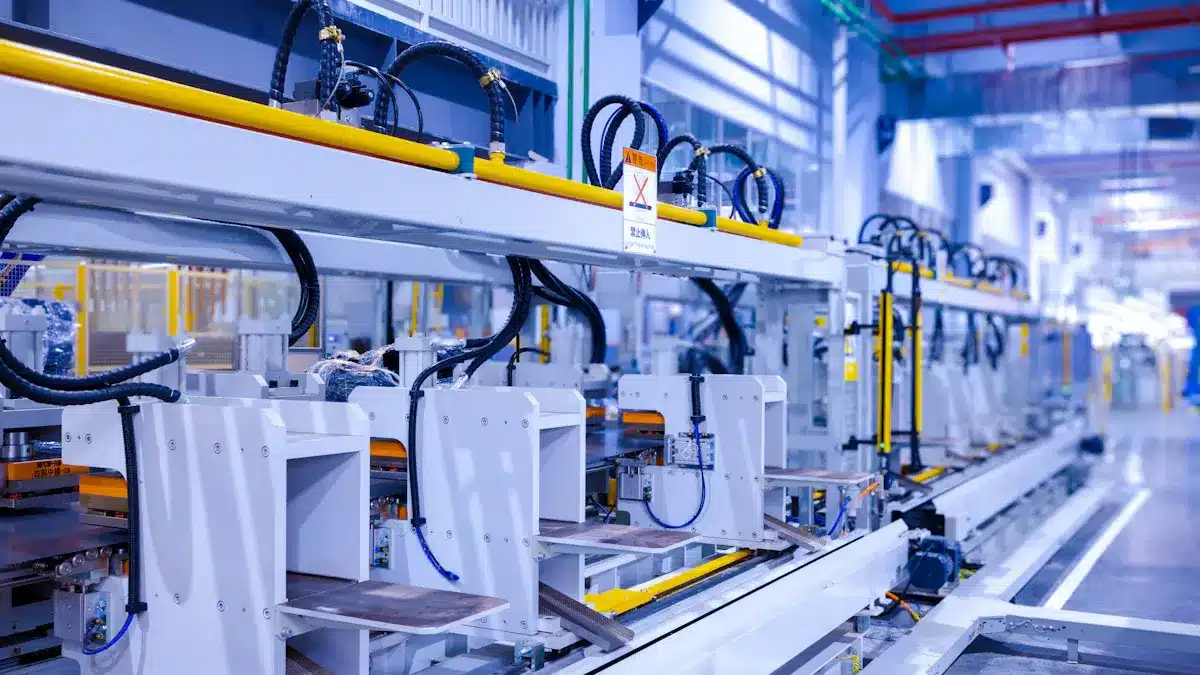
Printed Circuit Board (PCB) assembly is very important in today’s electronics. You use PCB assemblies in many devices. These include smartphones and medical equipment. The need for these assemblies has grown a lot lately. This is because of new technology and more people using electronics. For example, the PCB Assembly Services Market is expected to grow. It will go from USD 90 billion in 2024 to USD 177.7 billion by 2031. This shows a growth rate of 5% each year. This growth comes from new ideas in cars and communication. This is especially true with electric cars and 5G technology. Knowing how the PCB assembly process works is important for anyone in electronics manufacturing.
Key Takeaways
PCB assembly changes empty circuit boards into working devices. It does this by securely attaching electronic parts.
Following clear steps helps make high-quality PCBs. These steps include design for assembly, solder paste application, component placement, soldering, and testing.
Surface Mount Technology (SMT) allows fast and automated assembly. It has a high part density, which is great for small and mass-produced devices.
Through-Hole Technology (THT) gives strong support and is easy to repair. It is best for durable and high-stress applications.
Picking the right assembly method and using strict quality control makes products more reliable. This also lowers costs and improves product performance.
PCB Assembly Overview
Printed circuit board assembly (PCBA) is when electronic parts are put on printed circuit boards (PCBs). This process changes bare PCBs, which only have copper lines, into working electronic devices. You can see PCBA as the last step in making PCBs. It makes sure all needed parts, like resistors, capacitors, and connectors, are firmly attached. This assembly is very important because it helps devices work properly.
PCB assemblies are very important in many industries. Here are some common uses:
Consumer Electronics: You find PCB assemblies in smartphones, computers, and home gadgets. They help make devices smaller and cheaper, making them more efficient.
Automotive Components: PCBs are key in media devices, control systems, and navigation tools. They can handle high temperatures and vibrations, keeping vehicles safe and reliable.
Medical Devices: PCB assemblies are crucial in equipment for checking health, like heart rate monitors and infusion pumps. These devices need to be very reliable and often use advanced technology to follow strict health rules.
LEDs: PCBs help control heat in LED lights, which you see in homes, cars, and medical tools. Their design makes them last longer and work better.
Industrial Equipment: In factories, PCB assemblies power machines and control systems. They are made to survive tough conditions, like vibrations and chemicals.
Knowing the PCB assembly process and its uses helps you understand the technology in everyday devices. As you learn about electronics, you’ll notice how important PCB assemblies are for creating new solutions.
PCB Assembly Steps

The PCB assembly process has several important steps. These steps change bare printed circuit boards into working electronic devices. Each step is key to making sure the final product is good and reliable. Here’s a look at the main steps in the PCB assembly process:
Design for Assembly (DFA)
Before starting the assembly, focus on the design. Design for Assembly (DFA) means making a PCB layout that makes assembly easier. You need to think about where to place parts, how far apart they are, and how to design pads. For example, keeping at least 1mm space between parts helps prevent soldering problems. Also, using standard parts can make assembly faster and reduce mistakes. Following DFA rules can lower costs and make the process better.
Solder Paste Application
After finalizing the design, the next step is to put solder paste on the PCB pads. This usually uses a stencil that matches the PCB layout. A squeegee pushes solder paste through the stencil onto the right pads. Automated screen printing is often used here, as it makes sure the paste is applied evenly. After putting on the solder paste, a 3D optical inspection checks the amount and position, making sure the paste is in the right place.
Component Placement
Once the solder paste is applied, you move to placing the components. Automated pick-and-place machines are often used for this job. These machines place components on the solder-pasted pads using programmed coordinates and advanced vision systems. This automation makes the process faster and more accurate, lowering the chance of human mistakes. Proper placement is very important, as misaligned parts can cause problems in the final product.
Soldering Techniques
The next step is soldering the components to the PCB. Two main techniques are used: reflow soldering and wave soldering.
Reflow Soldering: This method is mainly for surface mount technology (SMT). The PCB goes through a temperature-controlled reflow oven. Here, the solder paste melts and hardens, making strong electrical connections.
Wave Soldering: This technique is for through-hole components. The PCB moves over a wave of molten solder, which solders the leads that go into the holes. Both methods need careful temperature control to avoid problems like cold joints or solder bridges.
Inspection and Testing
After soldering, careful inspection and testing are very important to check the quality of the PCB assembly. Different methods are used, including:
Automated Optical Inspection (AOI): This method uses cameras to find surface problems like misaligned parts and soldering issues.
In-Circuit Testing (ICT): This electrical testing checks for shorts, opens, and faulty parts by probing all circuit nodes.
Functional Testing: This step checks that the assembled PCB works according to design specifications in real-world conditions.
These inspection methods help find problems early, reducing the need for rework and making sure the final product is high quality.
By learning these steps in the PCB assembly process, you can see how complex and precise it is to make reliable electronic devices. Each step helps improve the overall quality and function of the printed circuit board assembly.
Technologies in PCB Assembly

In PCB assembly, two main technologies are used: Surface Mount Technology (SMT) and Through-Hole Technology (THT). Each method has its own features, benefits, and downsides. Knowing these technologies helps you pick the best one for your projects.
Surface Mount Technology (SMT)
Surface Mount Technology (SMT) means putting components right on the surface pads of printed circuit boards. This method allows for tiny packages and many components on both sides of the board. SMT lets machines place parts quickly and uses reflow ovens to solder everything at once. About 90% of modern PCB assemblies use SMT because it has many benefits.
Here’s a quick look at the SMT assembly process:
Solder Paste Printing: You put solder paste on the PCB pads with a stencil.
Component Placement: Machines accurately place surface mount parts onto the paste.
Reflow Soldering: The assembly goes through a reflow oven where the solder paste melts and hardens, making strong solder joints.
The benefits of SMT include:
Higher Component Density: You can fit more parts in a smaller area, which is great for small devices.
Improved Reliability: SMT gives better solder joints and shorter paths for electricity, boosting performance.
Faster Assembly: Automated methods allow for quicker production times.
However, SMT also has some downsides:
Repair Complexity: You might need special tools and skills to fix things.
Higher Initial Costs: Setting up SMT manufacturing can be expensive.
Through-Hole Technology (THT)
Through-Hole Technology (THT) means putting component leads into holes drilled in a PCB and soldering them on the other side. This method gives stronger mechanical support than SMT, making it good for things that face physical stress.
THT is often used in:
Automotive Electronics: Parts need to handle vibrations and shocks.
Aerospace and Military Electronics: Reliability is very important in these areas.
High-Power Electronics: THT manages heat better than SMT.
The advantages of THT include:
Stronger Connections: THT’s stability makes it great for tough systems.
Ease of Repair: You can easily swap out parts, which helps during testing.
Broad Component Options: THT works with many different parts.
But THT also has some downsides:
Space Requirements: THT parts take up more room, making them less ideal for small designs.
Slower Assembly: The manual or semi-automated process is much slower than SMT.
Comparison of SMT and THT
To help you see the differences between SMT and THT, here’s a comparison table:
Aspect | Surface Mount Technology (SMT) | Through-Hole Technology (THT) |
|---|---|---|
Assembly Speed | Highly automated; can place thousands of components per hour; estimated 10–20x faster than THT | Manual or semi-automated insertion; significantly slower assembly |
Cost Efficiency | Higher initial setup costs but lower per-unit cost at scale due to automation | Lower initial setup costs but higher labor costs in mass production |
Suitable Use Cases | Large volume manufacturing where speed and cost per unit are critical | Low-volume prototyping or applications requiring mechanical robustness |
This comparison shows that SMT usually works better than THT in speed and cost for high-volume production. However, THT is still important for specific low-volume or strength-focused uses.
Considerations for PCB Assembly
Choosing the right way to assemble PCBs is very important for your project. Many things can affect this choice. Here are some key points to think about:
Evaluate Quality: Check the tools and certifications, like ISO 9001:2015. Look for customer reviews to make sure the assembly is high quality.
Explore Testing Options: Make sure there are good testing methods available, like automated optical inspection and in-circuit testing.
Ask About Customer Support: Ensure the assembly provider has helpful and knowledgeable support to assist you with your decisions.
Compare Costs: Think about order size, services needed, labor, shipping, and sourcing parts to find a balance between cost and value.
Watch for Red Flags: Be careful of slow responses, inflexibility, long wait times, and unclear high costs.
These points help you choose the best PCB assembly method for your project needs.
When looking at assembly techniques, consider what your product specifically needs. For example, if your project needs fast performance, you might prefer Surface Mount Technology (SMT). If you need strong support, Through-Hole Technology (THT) could be better.
Factor | Through-Hole Technology (THT) | Surface Mount Technology (SMT) |
|---|---|---|
Assembly Speed | Slower; often manual work; 500-1,000 boards per day | Much faster; machines place parts automatically; thousands of boards per day |
Application Suitability | Best for power electronics, transformers, connectors; strong support; used in industrial, automotive, military | Great for consumer electronics, mobile devices; compact and lightweight |
Cost | Higher cost for large production | Lower cost for high-volume production |
Reliability | Very reliable and durable under stress | Less reliable under extreme conditions |
Component Density | Lower density; larger boards | Higher density; compact designs |
Quality control is very important for making sure your PCB assembly is reliable. Using strict quality control helps lower defects and improve product performance. Here are some good quality control methods to think about:
Visual Inspection: Check at different stages, like initial checks, component inspections, and final evaluations. This helps find surface and assembly problems early.
Automated Optical Inspection (AOI): Use cameras and software for accurate detection of defects without contact. AOI can scan thousands of PCBs each hour, ensuring efficiency.
In-Circuit Testing (ICT): This checks electrical functionality by probing all circuit points. It helps catch defects early, lowering production costs and ensuring reliability.
Functional Testing: Make sure the assembled PCB works as it should in real-world conditions.
By using these quality control methods, you can make your PCB assembly more reliable. Regular audits, staff training, and advanced technologies like 3D AOI can help improve defect detection and process reliability.
In conclusion, knowing the PCB assembly process is very important for anyone in electronics manufacturing. New technology has changed this area a lot. You can use automation tools to make things faster and more accurate. Here are some main points to remember:
Better inspection systems find problems early, saving money on fixes.
New materials and soldering methods help create smaller, better PCBs.
These changes help speed up production and improve product quality. As you learn about PCB assembly, remember these advancements to keep up in the fast-changing electronics world.
FAQ
What is the PCB assembly process?
The PCB assembly process is about putting electronic parts on printed circuit boards. This process changes bare PCBs into working devices through steps like soldering and testing.
Why is quality control important in PCB assembly?
Quality control is important because it makes sure your PCB assemblies meet standards. It helps find problems early, which lowers the chance of failures in the final product. Good quality control makes devices more reliable and better.
What are the main steps in PCB assembly?
The main steps in PCB assembly are design for assembly, solder paste application, component placement, soldering techniques, and inspection and testing. Each step is very important for a successful assembly process.
How does pick and place assembly work?
Pick and place assembly uses machines to put components on the PCB accurately. These machines use programmed coordinates and advanced vision systems to ensure correct placement, making the process faster and reducing mistakes.
What types of testing are performed on PCBs?
Testing on PCBs includes electrical testing, automated optical inspection, and functional testing. These methods check the quality and function of the printed circuit board assembly, making sure it meets design requirements.